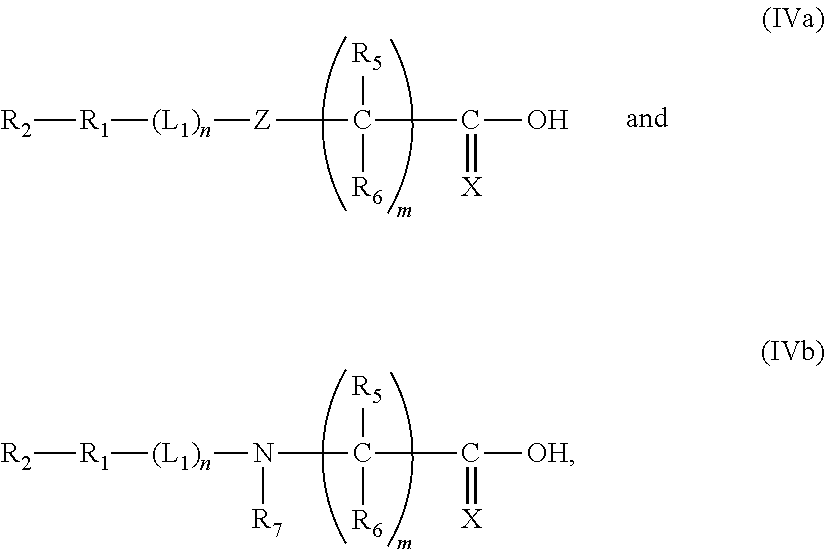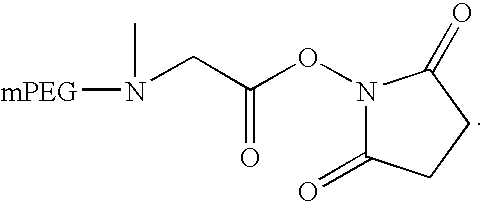Methods of preparing activated polymers having alpha nitrogen groups
a technology of alpha nitrogen group and activated polymer, which is applied in the field of methods of preparing activated polymers, can solve the problems of difficult to obtain high purity activated linkers or peg conjugates made therewith, and achieve the effects of low cost, high purity and high purity
- Summary
- Abstract
- Description
- Claims
- Application Information
AI Technical Summary
Benefits of technology
Problems solved by technology
Method used
Image
Examples
example 1
Preparation of 5 k mPEG-Ts
[0128]5 k mPEG-OH (compound 1, 50 g, 10 mmol) and DMAP (5.89 g, 48 mmol) were dissolved in 300 ml of CH2Cl2. Separately p-Toluenesulfonyl chloride (9.35 g, 50 mmol) was dissolved in 200 ml of CH2Cl2. The prepared p-Toluenesulfonyl chloride solution was then added to the 5 k mPEG-OH solution over 2 to 3 hours with additional funnel. The reaction mixture was stirred at room temperature overnight. 250 ml of CH2Cl2 was added to the reaction mixture followed by washing the reaction mixture with 0.1 N HCl twice. CH2Cl2 layer was separated and dried with MgSO4. The solvent was removed as much as possible. The residue was dissolved in 75 ml of CNCH3 and product was precipitated with addition of 1500 ml of IPA. The solids were filtered and washed with IPA twice and ether twice. The final product (compound 2) was dried under vacuum at 40 degrees (48.4 g, 96.8% yield). Purity>99% as judged by NMR.
[0129]13C NMR (CDCl3) δ 21.3 (—CH3), 58.6 (—OCH3), 68.2-71.4 (OCH2CH2O i...
example 2
Preparation of 5 k mPEG-Sarcosine (3)
[0130]NaOH (3.49 g, 87.31 mmol) and sarcosine (7.77 g, 87.31 mmol) were dissolved in 180 ml of H2O. 5 k mPEG-Ts (compound 2, 45 g, 8.73 mmol) was added. The reaction mixture was heated to 45 to 50 degrees C. and kept at this temperature for 12 hours followed by cooling to RT. The reaction mixture was extracted with CH2Cl2 twice. The combined CH2Cl2 layer was back washed with H2O. The organic layer was dried with MgSO4. The solvent was removed and the residue was dissolved in 110 ml of 0.25 N HCl. The product was extracted with CH2Cl2 twice. The combined CH2Cl2 layer was dried with MgSO4. The solvent was removed and the residue was dissolved in 130 ml of CH2Cl2 and the product was precipitated with 900 ml of ethyl ether. The final product (compound 3) was filtered, washed with ether and dried under vacuum at 40 degrees (38.8 g, 86.2% yield). Purity>95% as judged by NMR.
[0131]13C NMR (CDCl3) δ 42.0 (—NCH3), 54.2 (—CH2NCH2—), 58.6 (—OCH3), 65.5-71.4...
example 3
Preparation of 5 k mPEG-Sarcosine NHS
[0132]5 k mPEG-Sarcosine (compound 3, 15 g, 2.958 mmol) was dissolved in 100 ml of CH2Cl2. N-Hydroxysuccinimide (510 mg, 4.437 mmol). Diisopropylcarbodiimide (559 mg, 4.437 mmol) and 4-Dimethylamino-Pyridine (361 mg, 2.958 mmol) were added. The mixture was stirred at RT overnight. The reaction mixture was filtered. The solvent was removed as much as possible. The residue solids were dissolved in 30 ml of CH2Cl2 and precipitated with 350 ml of ethyl ether. The solids were filtered and washed with ether. The wet solids were re-crystallized from 750 ml of IPA. The solids were filtered, washed with IPA twice, ether twice. The product (compound 4) was dried under vacuum at 40 degrees (yield=13.5 g). 90% yield. Purity>95%.
[0133]13C NMR (CDCl3) δ 25.1 (—CH2CH2—), 42.0 (—NCH3), 54.8-54.9 (—CH2NCH2—), 58.5 (—OCH3), 68.8-71.4 (OCH2CH2O in PEG), 165.3 (—C═O), 168.5 (—O═CNC═O—).
PUM
| Property | Measurement | Unit |
|---|---|---|
| temperature | aaaaa | aaaaa |
| reaction time | aaaaa | aaaaa |
| weight average molecular weight | aaaaa | aaaaa |
Abstract
Description
Claims
Application Information
 Login to View More
Login to View More - R&D
- Intellectual Property
- Life Sciences
- Materials
- Tech Scout
- Unparalleled Data Quality
- Higher Quality Content
- 60% Fewer Hallucinations
Browse by: Latest US Patents, China's latest patents, Technical Efficacy Thesaurus, Application Domain, Technology Topic, Popular Technical Reports.
© 2025 PatSnap. All rights reserved.Legal|Privacy policy|Modern Slavery Act Transparency Statement|Sitemap|About US| Contact US: help@patsnap.com



